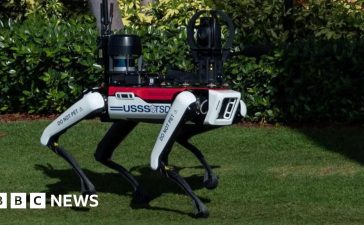The first release of Rhino Linux brings the rolling release model of Arch Linux to an Ubuntu base, along with the do-it-yourself ethos.
Rhino Linux 2023.1 is the first full release of a new distro we mentioned last October – as we did its progenitor, Rolling Rhino half a year before then. Rhino Linux is a rolling-release distro which draws on the basis of the current development branch of Ubuntu, combining some novel package-management tools inspired by Arch Linux, wrapped up with a custom Xfce-based desktop.
So this is an experimental, always-new distro for those who prize having the latest and greatest components over tedious, slow-moving static releases, combined with the compatibility and driver support of Ubuntu. If that sounds like fun, it may be for you. If constant change and ongoing maintenance sounds like a headache, and Arch sounds like too much work, perhaps look elsewhere.
Having followed the Rhino story for a while, we were keen to take a look at the first emission. The result is quite substantially different from Ubuntu – more so than we were expecting.

Rhino Linux’s default desktop layout looks quite like GNOME – but it doesn’t work like GNOME
Rhino uses the Calamares cross-distro installer, which it shares with quite a few other distros including Lubuntu. Once installed, if you dual-boot it with other distros, it shows up in the GRUB menu as “Ubuntu Mantic Minotaur (development branch) (23.10)”. The desktop is based on some components from Xfce, such as the GNOME-like top panel with a central clock, and a floating dock on the left, provided by plank.
On the first run, a wizard opens to ask a few questions about package management, for example offering the ability to turn off Snap and AppImage support… but on our installation on bare metal, it had forgotten the Wi-Fi password we entered into the live environment during setup, meaning there was no internet connection. As a result, the wizard crashed before it finished.
The desktop looks superficially like recent versions of GNOME, but it works quite differently: for instance, the panel button at the top left doesn’t open an overview, as it does in GNOME; instead, it’s the logout and shutdown control. Pressing the super (“Windows”) key doesn’t open one either, nor a search function; indeed, on its own, it doesn’t seem to do anything. There is a global search: it’s the first icon in the dock, oddly represented by what looks a capital J. Clicking it reveals that this is a tool called Ulauncher (apparently that’s not a “J”) and the shortcut is Super+S. This search function is separate from the app grid, which is the second icon in the dock. They both work fine, but both in a VM and on bare metal, there’s a perceptible pause before either opens, which in one move loses two key selling points of GNOME: its convenient combined app launcher and switcher, and the way it opens instantly at a tap of a single key.

So that’s not a J, it’s U for Ulauncher, which you open with Super-S. Consistency? We’ve heard of it
The third item on the dock is a virtual-desktop switcher, provided by Xfce’s xfdashboard. This opens up a set of virtual desktops in a panel on the right of the screen – again, cosmetically similar to GNOME, but working differently. It’s redundant and it’s superflous: Xfce needs no add-ons to offer an auto-hiding vertical virtual-desktop switcher on the right, or wherever else the developers choose to put it, such as in the largely empty and wasted top panel.
Rhino has several package management tools installed, including the nala command-line tool we first saw in the Zinc de-Snapped Ubuntu remix. We tried doing an update with that, which found a few components, but not as many as we’d expect to see in a rolling-release distro. Later, we noticed the instructions in the release announcement:
This found lots more updates, including a new kernel build and more. There are a few lessons from this.
Firstly, just because this is an Ubuntu-based distro, you musn’t assume that methods from Ubuntu will be enough; they won’t.
Secondly, Rhino appears to have various package-management-related tools, and they don’t seem to interoperate very smoothly. For example, like most packaging tools in Debian-based distros, Nala needs to be run as root, or using sudo, to work. Rhino’s pacstall, on the other hand, won’t run in a root shell, so if you run the rpk command in one, it throws an error and fails to complete. You must run it as an unprivileged command.
Having two tools for one job is not good, but when they have clashing requirements, that’s bad.
There are not many Ubuntu-specific tools here, such as the global Settings control panel, or the software-properties-gtk program for finding local repo mirrors and installing proprietary drivers. When we manually installed the latter, it wouldn’t open. In fact, we couldn’t find a driver installer in Rhino at all, and on our test Thinkpad W520, manually installing the Nvidia drivers from a shell meant that the desktop wouldn’t load when we rebooted.
We rebooted and tried going into rescue mode, connecting an Ethernet cable – the Wi-Fi wasn’t configured, and we couldn’t find shell commands to do so – and adding the Bumblebee tools for Nvidia Primus GPU switching. We rebooted, but that didn’t work either. We rebooted into rescue mode again and expunged all traces of Nvidia. We rebooted again, and that restored the Intel integrated GPU to life.

Rhino also bundles Xfdashboard, which has its own search tool and app launcher – as well as a virtual desktop switcher
This is a first release of not just a new distro, but a new type of distro with its own tooling: a rolling-release Ubuntu. A few rough edges here and there are fair enough. As we wrote before, the team behind it are all pretty young, and we like to see experiments like this. The desktop is innovative, and the distro has its own unique look. That’s good.
There is substantial redundancy here, and that is not a good thing. There are multiple package managers: apt, and apt-get, plus nala, and also pacstall, plus rpkg, which wraps pacstall and nala – as well as Snap and Flatpak if they’re installed. This is not just overkill, it’s misleading: having a tool such as Nala installed led us to expect that we could upgrade the system with it, but it won’t do a complete job. If users must use rpkg to do that, the maintainers should remove as many of the others as possible, rather than adding extra APT front-ends. There’s the search-driven Ulauncher, but there’s also Xfdashboard, which does that and provides a overview and virtual desktops. There are two panels on the desktop, both an Xfce top panel as well as Plank. That makes Plank superfluous: Xfce can do a better dock, with more customization options, on its own, especially with the docklike plugin.
Given some time, Rhino Linux may get a bit more polished. At this early stage, though, there is far too much duplication for our comfort: Ulauncher plus Xfdashboard; an Xfce panel plus Plank; Nala plus rpk; and so on. If the developers want to offer a GNOME-like desktop layout – which would not be this vulture’s first choice, but chacun à son goût – then provide GNOME-like controls in GNOME-like locations and using GNOME-like keystrokes. There is real potential here, but it’s been some 18 months since we first covered this distro’s ancestor, and we would have hoped some of these rough edges would have already been shaved off by now. ®









